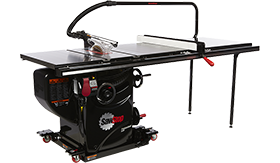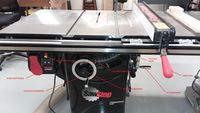Difference between revisions of "Table Saw"
| Line 64: | Line 64: | ||
====General Procedure==== | ====General Procedure==== | ||
| − | [[File:TABLE SAW CONTROLS.jpg| | + | [[File:TABLE SAW CONTROLS.jpg|border|200px|Picture of table saw]] |
'''Rip cut''' | '''Rip cut''' | ||
Revision as of 12:00, 25 June 2019
Make: SawStop
Model: PCS31230
Ace: Needed (Makerhub@georgefox.edu).
Location: Wood Shop
Description
The table saw is a fundamental part of any woodshop and can be used for cutting wood or acrylic. There are two basic cuts that are normally performed. A rip cut is made along the grain and a cross cut is done perpendicular to the the grain. A fence is used to keep the material straight when pushing material through the saw. While the saw is usually used for cutting the long side of material, jigs and tools are also available for doing cross-cuts on the table saw. Fixtures make sure the material stays in place as it’s pushed through and helps keep it straight.
The SawStop table saw has a unique safety feature. A spring loaded cartridge is located in the machine. Any conductive material that makes contact with the blade fires and jams the cartridge block into the blade. The blade then stops spinning and drops down out of the way into the body of the saw. All this happens within 5 milliseconds, helping to ensure the blade inflicts minimal damage. If the material you are cutting is wet or has gold paint or leaf it will most likely trigger the saw stop feature. Do not cut any wet lumber or metal coated materials with this machine. Charcoal is also conductive so any laser cut areas of lumber should not make contact with the blade while cutting.
Here is an example of this piece of equipment being used.
Documentation
Terminology
- Rip - Cuts made along the length of the wood
- Cross-cut - Cuts made across the grain along the shorter side of the wood
- Push stick - A piece of wood or plastic used to push the wood being cut through the blade while keeping fingers away from the blade
- Fence - A guide for measuring the cut and guiding the wood
- Riving Knife - A flat metal device that mounts behind the saw blade. This device prevents material from closing up on the blade and causing a dangerous condition called a material kickback.
Training
Operation
The SawStop table saw has a unique safety feature. A spring loaded cartridge is located in the machine. Any conductive material that makes contact with the blade causes the cartridge block to fire into the blade. The blade then stops spinning and drops down out of the way. All this happens within 5 milliseconds, helping to ensure the blade inflicts minimal damage. If the material you are cutting is conductive it will trigger the saw stop feature. Do not cut any wet lumber, pressure treated, or metal coated materials such as gold leaf with this machine. Charcoal is also conductive so any laser cut areas of lumber should not make contact with the blade while cutting.
When setting up the saw the blade, it should protrude no more than 1/4" above the material top. This limits the amount of blade that is exposed.
Make sure the material you are cutting is free of all foreign objects. Do not cut materials that may have nails or screws as they will damage the blade and may cause injury to you. If the material contains a loose knot it can break free and create a safety hazard.
The dust collector must be used with the table saw to help keep the dust out of the air.
Demonstration
Demonstrate you can safely setup the saw and rip a board. You will then proceed to cross cut one of the remaining piece. Remember to set the blade height so it is protruding less than 1/8" out the top of material for less exposure. When performing a rip cut the fence is used to guide the lumber into the blade. You want to make sure that the distance between the fence and blade is the width of desired cut. Mark the edge of the material when doing a cross cut so you can align the material with the blade in the sled. You can also use a miter gauge for making cross cuts but make sure the material is long enough and well supported.
General Procedure
Rip cut
1. Ensure that the material you are cutting has at least one straight edge and no nails or foreign objects. The straight edge will slide against the fence when ripping.
2. Measure the width of the board and determine the width of cut desired.
3. Lift the locking handle on the fence and slide the fence to the desired cut width using the scale. Make sure you use the scale for the correct side of the blade.
4. Lock the fence by pressing down on the locking handle.
5. Use the blade lift handle on the front of the saw to set the height of the blade approximately 1 tooth above the height of the material by placing the material next to the blade. This limits the exposed blade.
6. Turn on the power switch on the front of the saw and the dust collector. The green light on the saw will flash and turn solid green when the saw is ready.
7. Make sure nothing is touching the blade. Turn on the saw by gently pulling on the red paddle switch located on the front of the machine. The paddle switch is also the off switch when pressed.
8. Line up the flat side of the material with the fence without touching the blade. The fence is a guide and the material should be pressed firmly into the fence as well as down on the table.
9. Slowly feed the material in towards the blade while keeping your fingers clear of the blade. Use a push stick to keep your fingers away from the blade.
10. Make sure you keep a firm hold on the material and do not stop feeding the material until it has passed beyond the blade.
11. It is helpful to have someone assisting on the back side of the saw to help hold material being fed off the table.
12. When the saw cut is complete, press in on the paddle switch to turn off the saw.
Cross Cut
1. Move the fence off to the side by lifting the brake handle and sliding the fence off to the side.
2. Place the cross cut sled on the table by aligning the table slots with the rails on the sled.
3. Slide the sled over the blade and use the material to set the blade height using the blade height handle on the front of the saw. The blade should be roughly one tooth taller than the top of the material.
4. Place the material flat edge against the back of the sled and align the material with the edge of the blade.
5. Once the blade is clear pull the red paddle switch to turn on the saw.
6. Slide the sled forward to cut through the material at the desired location.
7. Slide the sled back to you so it clears the blade.
8. Power down the saw by pressing the red paddle switch located on the front of the machine.
9. Lower the blade below the table using the crank handle on the front of the machine.
10. Reset the space.
Safety
There are hazards you need to be aware of when using a table saw. The blade is very sharp and it spins very fast. Keep your fingers away from the blade even when its not spinning. Use a push stick to keep your fingers a safe distance from the blade. Hold onto material firmly and keep it against the table and fence. If material catches on the blade the material can shoot back at you and this is called a kickback.
This is a video of a kickback:
Certification
Foxtale Quiz https://foxtale.georgefox.edu/moodle/mod/quiz/view.php?id=812007
Troubleshooting
If the blade appears to need sharpening ask the tech to change out the blade.
A sign of a dull blade is as follows:
1. Burning of material
2. More resistance when cutting
3. Rough cut edges
4. Increased cutting noise
5. Increased motor noise
Maintenance
General maintenance
Keep the saw clean and use the dust collector. There are several lubrication points on the saw that need to be checked by the tech.
Specific Maintenance Tasks
| Maintenance Procedure | Frequency | Done By |
|---|---|---|
| Sample | Sample | Sample |
| Sample2 | Sample2 | Sample2 |

